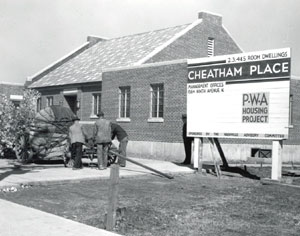
Public Works Administration (PWA)
Organized with funds from the National Industrial Recovery Act of June 1933, the Public Works Administration (PWA) was one of the New Deal’s several attempts to revive the nation’s depression-ridden economy. Designed to provide unemployed workers with wages as well as to stimulate the building industry, the PWA’s main focus was on large-scale construction projects. From 1933 to 1939, the PWA spent six billion dollars in constructing 70 percent of all educational buildings built in the country; 65 percent of all the courthouses, city halls, and other nonresidential public buildings; 65 percent of all the sewage treatment plants; 35 percent of the hospitals and public-health facilities; and 10 percent of the roads, streets, and bridges. The PWA also completed numerous public housing and public utilities projects.
In the South, where the Great Depression had only worsened an already lame economy and where urban infrastructures were inadequate and public and private construction had virtually stopped, the PWA eventually made a noticeable difference. From 1933 to 1938 the South received over $500 million from the PWA. Besides the many miles of roads it surfaced and hundreds of buildings it constructed, the PWA in the South built Florida’s Key West Highway, Atlanta’s Techwood housing complex, the man-made port at Brownsville, Texas, the Virginia State Library in Richmond, Charity Hospital in New Orleans, and a water supply system in rural Alabama.
In Tennessee, the PWA employed thousands of jobless workers. It built, surfaced, and resurfaced over two hundred miles of roads over the state, built numerous bridges and rail crossings, paved city streets, repaired power plants, constructed waterworks, and helped erect numerous public buildings, including new county courthouses in Davidson, Franklin, Lauderdale, Lewis, Madison, Obion, and Sumner Counties.
In its large construction projects, the PWA especially was active in Tennessee’s cities. For instance, PWA boosted Nashville’s dollar-poor public education system by building several new elementary and junior high schools, West End High School, and the Pearl High School for African American students. PWA workers also built schools in Chattanooga, Knoxville, Jackson, and Memphis.
At the same time, the PWA began over fifty housing projects in twenty-nine states, including Tennessee. In Memphis the PWA constructed the Lauderdale Courts for white tenants and the Dixie Homes for blacks. In Nashville PWA workers built the Andrew Jackson Courts for African American residents and Cheatham Place for whites.
In Tennessee, the presence of the PWA may have been more prominent than in other states because of its association with the Tennessee Valley Authority (TVA) in providing electric power for its citizens. Municipalities such as Knoxville and Chattanooga obtained PWA financing for the construction of public power distribution centers and local power stations; smaller towns like Lewisburg also benefited from new power distribution centers. PWA loans also helped bring TVA electricity to thousands of Tennesseans over the state.
PWA grants to cities for large-scale construction projects permanently changed urban landscapes in Tennessee. In Memphis, the PWA built a juvenile court building, the John Gaston Hospital, and dormitories at the University of Tennessee Medical School. In Chattanooga, besides its rather substantial school construction program, the PWA added a building to Silverdale Hospital, constructed the combined Public-University of Chattanooga Library building, and financed an addition to the Hamilton County Courthouse. In Knoxville, PWA funds added buildings to the sprawling campus of the University of Tennessee. The PWA especially was generous to Nashville. There it helped construct the Tennessee Supreme Court Building, the State Office Building, a new post office on Broadway, and the Davidson County Public Building and Courthouse on the city’s Public Square.
By the late 1930s, growing opposition to the New Deal and the approach of World War II resulted in a shift of public spending from civilian to military construction. Ongoing PWA projects received final funding and the agency was terminated, but in Tennessee, almost six hundred projects costing federal and local governments $90 million had not only provided wages for thousands of depression-weary Tennesseans but had enhanced significantly the physical portrait of the Volunteer State.
Suggested Reading
Roger Biles, Memphis in the Great Depression (1986); John D. Minton, The New Deal in Tennessee, 1932-1938 (1979)



